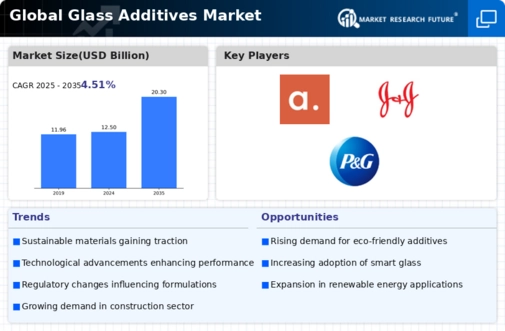Glass Additives Size
Glass Additives Market Growth Projections and Opportunities
The glass additives market is influenced by various factors that shape its dynamics and growth patterns. One of the significant drivers of this market is the increasing demand for glass additives in the construction and automotive industries. Glass additives play a crucial role in enhancing the properties of glass, such as strength, durability, transparency, and thermal insulation. In the construction sector, glass additives are used in the manufacturing of energy-efficient windows, architectural glass, and fiberglass reinforcements, contributing to the market's growth. Similarly, in the automotive industry, glass additives are utilized in automotive glass production to improve visibility, safety, and aesthetics, driving market demand.
Technological advancements in glass additives formulations and manufacturing processes also drive market growth. Manufacturers are continually innovating to develop new additives that offer enhanced performance, such as anti-glare coatings, UV inhibitors, and scratch-resistant additives. Additionally, advancements in nanotechnology enable the production of nano-sized additives that provide superior optical clarity and mechanical strength to glass products, further expanding the market potential across various industries.
Moreover, regulatory standards and environmental concerns play a significant role in shaping the glass additives market. Governments worldwide are imposing stricter regulations on emissions, energy efficiency, and product safety, driving the demand for eco-friendly additives. Glass additives that comply with regulatory standards, such as low VOC (volatile organic compound) emissions and non-toxic formulations, are gaining traction in the market. Additionally, growing awareness of sustainability and environmental protection is driving the adoption of recycled glass additives, further fueling market growth.
The competitive landscape of the glass additives market also influences its dynamics and growth trajectory. With numerous players competing for market share, competition is intense in terms of product innovation, quality, and pricing. Manufacturers are investing in research and development to introduce novel additives that offer unique properties and address specific customer needs. Strategic collaborations, partnerships, and acquisitions are also common strategies adopted by companies to strengthen their market presence and gain a competitive edge.
Furthermore, economic factors such as GDP growth, construction activities, and automotive production impact the glass additives market. Economic growth stimulates infrastructure development, urbanization, and construction projects, driving the demand for glass additives in architectural glass, fiberglass reinforcements, and energy-efficient windows. Similarly, rising automotive production and sales contribute to the demand for automotive glass additives used in vehicle windshields, windows, and sunroofs, further fueling market growth.







Leave a Comment